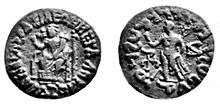Demeter
| Demeter | |
|---|---|
| Goddess of agriculture, fertility, and the harvest | |
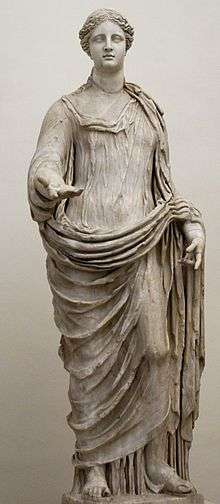 A marble statue of Demeter, National Roman Museum | |
| Other names | Sito, Thesmophoros |
| Abode | Mount Olympus |
| Symbol | Cornucopia, wheat, torch, bread |
| Consort | Iasion, Zeus, Oceanus, Karmanor, Poseidon and Triptolemus |
| Parents | Cronus and Rhea |
| Siblings | Hestia, Hera, Hades, Poseidon, Zeus, Chiron |
| Children | Persephone, Despoina, Arion, Plutus, Philomelus, Eubuleus, Chrysothemis, and Amphitheus I |
| Roman equivalent | Ceres |
| Festivals | Thesmophoria |
| Part of a series on | ||||||
| Ancient Greek religion | ||||||
|---|---|---|---|---|---|---|
 | ||||||
|
Godheads
|
||||||
|
Ethics |
||||||
|
Practices |
||||||
|
| ||||||
In ancient Greek religion and Greek mythology, Demeter (/dᵻˈmiːtər/; Attic: Δημήτηρ Dēmḗtēr; Doric: Δαμάτηρ Dāmā́tēr) is the goddess of the harvest and agriculture, who presided over grains and the fertility of the earth. Her cult titles include Sito (Σιτώ), "she of the Grain",[1] as the giver of food or grain,[2] and Thesmophoros (θεσμός, thesmos: divine order, unwritten law; φόρος, phoros: bringer, bearer), "Law-Bringer," as a mark of the civilized existence of agricultural society.[3]
Though Demeter is often described simply as the goddess of the harvest, she presided also over the sacred law, and the cycle of life and death. She and her daughter Persephone were the central figures of the Eleusinian Mysteries that predated the Olympian pantheon. In the Linear B Mycenean Greek tablets of circa 1400–1200 BC found at Pylos, the "two mistresses and the king" may be related with Demeter, Persephone and Poseidon.[4][5] Her Roman equivalent is Ceres.[6]
Etymology
It is possible that Demeter appears in Linear A as da-ma-te on three documents (AR Zf 1 and 2, and KY Za 2), all three apparently dedicated in religious situations and all three bearing just the name (i-da-ma-te on AR Zf 1 and 2).[7] It is unlikely that Demeter appears as da-ma-te in a Linear B (Mycenean Greek) inscription (PY En 609); the word 𐀅𐀔𐀳, da-ma-te, probably refers to "households".[8][9] On the other hand, 𐀯𐀵𐀡𐀴𐀛𐀊, si-to-po-ti-ni-ja, "Potnia of the Grain", is regarded as referring to her Bronze Age predecessor or to one of her epithets.[10]
Demeter's character as mother-goddess is identified in the second element of her name meter (μήτηρ) derived from Proto-Indo-European *méh₂tēr (mother).[11] In antiquity, different explanations were already proffered for the first element of her name. It is possible that Da (Δᾶ),[12] a word which became Ge (Γῆ) in Attic, is the Doric form of De (Δῆ), "earth", the old name of the chthonic earth-goddess, and that Demeter is "Mother-Earth".[13] This root also appears in the Linear B inscription E-ne-si-da-o-ne, "earth-shaker", as an aspect of the god Poseidon.[14][15] However, the dā element in the name of Demeter is not so simply equated with "earth" according to John Chadwick.[16][17]
The element De- may be connected with Deo, a surname of Demeter[18] probably derived from the Cretan word dea (δηά), Ionic zeia (ζειά)—variously identified with emmer, spelt, rye, or other grains by modern scholars—so that she is the Mother and the giver of food generally.[19] The Arcadian cult to Demeter links her to a male deity (Greek: Πάρεδρος, Paredros), who accompanied the Great Goddess and has been interpreted as a possible substitution for Poseidon; Demeter may therefore be related to a Minoan Great Goddess (Cybele).[20]
An alternative Proto-Indo-European etymology comes through Potnia and Despoina, where Des- represents a derivative of PIE *dem (house, dome), and Demeter is "mother of the house" (from PIE *dems-méh₂tēr).[21]
Agricultural deity
According to the Athenian rhetorician Isocrates, Demeter's greatest gifts to humankind were agriculture, particularly of cereals, and the Mysteries which give the initiate higher hopes in this life and the afterlife.[22] These two gifts were intimately connected in Demeter's myths and mystery cults. In Homer's Odyssey she is the blond-haired goddess who separates the chaff from the grain.[23] In Hesiod, prayers to Zeus-Chthonios (chthonic Zeus) and Demeter help the crops grow full and strong.[24] Demeter's emblem is the poppy, a bright red flower that grows among the barley.[25]
In Hesiod's Theogony, Demeter is the daughter of Cronus and Rhea. At the marriage of Cadmus and Harmonia, Demeter lured Iasion away from the other revelers. They had intercourse in a ploughed furrow in Crete, and she gave birth to a son, Ploutos.[26] Her daughter by Zeus was Persephone, Queen of the Underworld.[27]
Festivals and cults
Demeter's two major festivals were sacred mysteries. Her Thesmophoria festival (11–13 October) was women-only.[28] Her Eleusinian mysteries were open to initiates of any gender or social class. At the heart of both festivals were myths concerning Demeter as Mother and Persephone as her daughter.
Myths
Demeter and Persephone
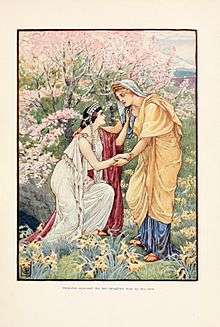
Demeter's virgin daughter Persephone was abducted to the underworld by Hades. Demeter searched for her ceaselessly, preoccupied with her loss and her grief. The seasons halted; living things ceased their growth, then began to die.[29] Faced with the extinction of all life on earth, Zeus sent his messenger Hermes to the underworld to bring Persephone back. Hades agreed to release her if she had eaten nothing while in his realm; but Persephone had eaten a small number of pomegranate seeds. This bound her to Hades and the underworld for certain months of every year, either the dry Mediterranean summer, when plant life is threatened by drought,[30] or the autumn and winter.[31] There are several variations on the basic myth. In the Homeric hymn to Demeter, Hecate assists in the search and later becomes Persephone's underworld attendant.[32] In another, Persephone willingly and secretly eats the pomegranate seeds, thinking to deceive Hades, but is discovered and made to stay. In all versions, Persephone's time in the underworld corresponds with the unfruitful seasons of the ancient Greek calendar, and her return to the upper world with springtime. Demeter's descent to retrieve Persephone from the underworld is connected to the Eleusinian Mysteries.
Demeter and her daughter Persephone were usually called:[33]
- The goddesses, often distinguished as "the older" and "the younger" in Eleusis.
- Demeters, in Rhodes and Sparta
- The thesmophoroi, "the legislators" in the Thesmophoria.
- The Great Goddesses, in Arcadia.
- The mistresses in Arcadia.[34]
In Mycenaean Pylos, Demeter and Persephone were probably called "queens" (wa-na-ssoi).[5]
The myth of the capture of Persephone seems to be pre-Greek. In the Greek version, Ploutos (πλούτος, wealth) represents the wealth of the corn that was stored in underground silos or ceramic jars (pithoi). Similar subterranean pithoi were used in ancient times for funerary practices. At the beginning of the autumn, when the corn of the old crop is laid on the fields, she ascends and is reunited with her mother Demeter, for at this time the old crop and the new meet each other.[35]
According to the personal mythology of Robert Graves,[36] Persephone is not only the younger self of Demeter,[37] she is in turn also one of three guises of the Triple Goddess – Kore (the youngest, the maiden, signifying green young grain), Persephone (in the middle, the nymph, signifying the ripe grain waiting to be harvested), and Hecate (the eldest of the three, the crone, the harvested grain), which to a certain extent reduces the name and role of Demeter to that of group name. Before her abduction, she is called Kore; and once taken she becomes Persephone ('she who brings destruction').[38]
Demeter at Eleusis

Demeter's search for her daughter Persephone took her to the palace of Celeus, the King of Eleusis in Attica. She assumed the form of an old woman, and asked him for shelter. He took her in, to nurse Demophon and Triptolemus, his sons by Metanira. To reward his kindness, she planned to make Demophon immortal; she secretly anointed the boy with ambrosia and laid him in the flames of the hearth, to gradually burn away his mortal self. But Metanira walked in, saw her son in the fire and screamed in fright. Demeter abandoned the attempt. Instead, she taught Triptolemus the secrets of agriculture, and he in turn taught them to any who wished to learn them. Thus, humanity learned how to plant, grow and harvest grain. The myth has several versions; some are linked to figures such as Eleusis, Rarus and Trochilus. The Demophon element may be based on an earlier folk tale.[39]
Demeter and Poseidon
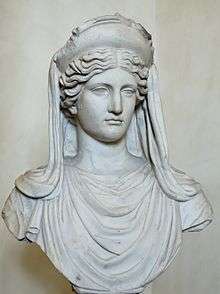
Demeter and Poseidon's names appear in the earliest scratched notes in Linear B found at Mycenae and Mycenaean Pylos; e-ne-si-da-o-ne (earth-shaker) for Poseidon, and si-to-po-ti-ni-ja, who is probably related with Demeter.[40] Poseidon carries frequently the title wa-na-ka (wanax) in Linear B inscriptions, as king of the underworld, and his title E-ne-si-da-o-ne indicates his chthonic nature. In the cave of Amnisos (Crete) Enesidaon is related with the cult of Eileithyia, the goddess of childbirth.[41] She was related with the annual birth of the divine child.[42] During the Bronze Age, a goddess of nature, dominated both in Minoan and Mycenean cult, and Wanax (wa-na-ka) was her male companion (paredros) in Mycenean cult.[41] She and her paredros survived in the Eleusinian cult, where the following words were uttered : " Mighty Potnia bore a strong son"[43] However, there is no evidence that originally the name of Potnia was Demeter.
Tablets from Pylos record sacrificial goods destined for "the Two Queens and Poseidon" ("to the Two Queens and the King" :wa-na-ssoi, wa-na-ka-te). The "Two Queens" may be related with Demeter and Persephone, or their precursors, goddesses who were not associated with Poseidon in later periods.[5] An exception is the myth of isolated Arcadia in southern Greece. Despoina, is daughter of Demeter and Poseidon Hippios, Horse-Poseidon. These myths seem to be connected with the first Greek-speaking people who came from the north during the Bronze age. Poseidon represents the river spirit of the underworld and he appears as a horse as it often happens in northern-European folklore. He pursues the mare-Demeter and she bears one daughter who obviously originally had the form or the shape of a mare too. Demeter and Despoina were closely connected with springs and animals, related to Poseidon as a God of waters and especially with Artemis, the mistress of the animals and the goddess of, among others, the Hunt.
Demeter as mare-goddess was pursued by Poseidon, and hid from him among the horses of King Onkios, but could not conceal her divinity. In the form of a stallion, Poseidon caught and covered her. Demeter was furious (erinys) at Poseidon's assault; in this furious form, she is known as Demeter Erinys. But she washed away her anger in the River Ladon, becoming Demeter Lousia, the "bathed Demeter".[44] "In her alliance with Poseidon," Karl Kerenyi noted,[45] "she was Earth, who bears plants and beasts, and could therefore assume the shape of an ear of grain or a mare." She bore a daughter Despoina (Δέσποινα: the "Mistress"), whose name should not be uttered outside the Arcadian Mysteries,[46] and a horse named Arion, with a black mane and tail.
In Arcadia, Demeter's mare-form was worshiped into historical times. Her xoanon of Phigaleia shows how the local cult interpreted her: a Medusa type with a horse's head with snaky hair, holding a dove and a dolphin, probably representing her power over air and water.[47]
The second mountain, Mt. Elaios, is about 30 stades from Phigaleia, and has a cave sacred to Demeter Melaine ["Black"]... the Phigalians say, they accounted the cave sacred to Demeter, and set up a wooden image in it. The image was made in the following fashion: it was seated on a rock, and was like a woman in all respects save the head. She had the head and hair of a horse, and serpents and other beasts grew out of her head. Her chiton reached right to her feet, and she held a dolphin in one hand, a dove in the other. Why they made the xoanon like this should be clear to any intelligent man who is versed in tradition. They say they named her Black because the goddess wore black clothing. However, they cannot remember who made this xoanon or how it caught fire; but when it was destroyed the Phigalians gave no new image to the goddess and largely neglected her festivals and sacrifices, until finally barrenness fell upon the land.— Pausanias, Description of Greece 8.42.1ff.
Titles and functions
Demeter's epithets show her many religious functions. She was the "Corn-Mother" who blesses the harvesters. Some cults interpreted her as "Mother-Earth". Demeter may be linked to goddess-cults of Minoan Crete, and embody aspects of a pre-Hellenic Mother Goddess.[48] It is possible that the title "Mistress of the labyrinth", which appears in a Linear B inscription, belonged originally to Sito ("[she] of the grain"), the Great Mother Demeter and that in the Eleusinian mysteries this title was kept by her daughter Persephone (Kore or Despoina).[49] However, there is not any evidence that the name of Potnia in Eleusis was originally Demeter. Her other epithets include:
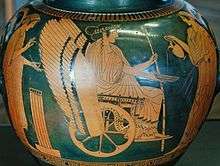
- Aganippe ("the Mare who destroys mercifully", "Night-Mare")
- Potnia ("mistress") in the Homeric Hymn to Demeter. Hera especially, but also Artemis and Athena, are addressed as "potnia" as well.
- Despoina ("mistress of the house"), a Greek word similar to the Mycenean potnia. This title was also applied to Persephone, Aphrodite and Hecate.
- Thesmophoros ("giver of customs" or even "legislator"), a role that links her to the even more ancient goddess Themis,[3] derived from thesmos, the unwritten law.[50] This title was connected with the Thesmophoria, a festival of secret women-only rituals in Athens connected with marriage customs.
- Erinys ("implacable"),[51] with a function similar with the function of the avenging Dike (Justice), goddess of moral justice based on custom rules who represents the divine retribution,[52] and the Erinyes, female ancient chthonic deities of vengeance and implacable agents of retribution.
- Chloe ("the green shoot"),[53] that invokes her powers of ever-returning fertility, as does Chthonia.
- Chthonia ("in the ground"), chthonic Demeter in Sparta.[54]
- Anesidora ("sending up gifts from the earth") applied to Demeter in Pausanias 1.31.4, also appears inscribed on an Attic ceramic a name for Pandora on her jar. There was a temple of Demeter under this name in Phlius in Attica.[55][56][57]
- Europa ("broad face or eyes") at Livadeia of Boeotia. She was the nurse of Trophonios to whom a chthonic cult and oracle was dedicated.[58]
- Kidaria in the mysteries of Pheneos in Arcadia[59] where the priest put on the mask of Demeter kept in a secret place. It seems that the cult was connected with the underworld and with an agrarian magic.[60]
Demeter might also be invoked in the guises of:
- Malophoros ("apple-bearer" or "sheep-bearer", Pausanias 1.44.3)
- Lusia ("bathing", Pausanias 8.25.8)
- Thermasia ("warmth", Pausanias 2.34.6)
- Achaea, the name by which she was worshipped at Athens by the Gephyraeans who had emigrated from Boeotia.[61][62]
Theocritus, wrote of an earlier role of Demeter as a poppy goddess:
- For the Greeks Demeter was still a poppy goddess
- Bearing sheaves and poppies in both hands. — Idyll vii.157
In a clay statuette from Gazi (Heraklion Museum, Kereny 1976 fig 15), the Minoan poppy goddess wears the seed capsules, sources of nourishment and narcosis, in her diadem. "It seems probable that the Great Mother Goddess, who bore the names Rhea and Demeter, brought the poppy with her from her Cretan cult to Eleusis, and it is certain that in the Cretan cult sphere, opium was prepared from poppies" (Kerenyi 1976, p 24).
Cult places
Major cults to Demeter are known at Eleusis in Attica, Hermion (in Crete), Megara, Celeae, Lerna, Aegila, Munychia, Corinth, Delos, Priene, Akragas, Iasos, Pergamon, Selinus, Tegea, Thoricus, Dion (in Macedonia)[63] Lykosoura, Mesembria, Enna (Sicily), and Samothrace.
An ancient Amphictyony, probably the earliest centred on the cult of Demeter at Anthele (Ἀνθήλη), which lay on the coast of Malis south of Thessaly. This was the locality of Thermopylae.[64][65]
After the "First Sacred War", the Anthelan body was known thenceforth as the Delphic Amphictyony[64]
Demeter of Mysia had a seven-day festival at Pellené in Arcadia.[66] Pausanias passed the shrine to Demeter at Mysia on the road from Mycenae to Argos but all he could draw out to explain the archaic name was a myth of an eponymous Mysius who venerated Demeter.
Genealogy
| Demeter's family tree [67] | |||||||||||||||||||||||||||||||||||||||||||||||||||||||||||||||||||||||||||||||||||||||||||||||||||||||||||||||||||||||||||||||||||||||||||||||||||||||||||||||||||||||||||||||||||||||||||||||||||||||||||||||||||||||||||||||||||||||||||||||||||||||||||||||||||||||||||||||||||||||||||||||||||||||||||||||||||||||||||||||||||||||||||||||||||||||||||||||||||||||||||||||||||||||||||||||||||||||||||||||||||||||||||||||||||||||||||||||||||||||||||||||||||||||||||||||||||||||||||||||||||||||||||||||||||||||||||||||||||||||||||||||||||||||||||||||||||||||||||||||||||||||||||||||||||||||||||||||||||||||||||||||||||||||||||||||||||||||||||||||||||||||||||||||||||||||||||||||||||||||||||||||||||||||||||||||||||||||||||||||||||||||||||||||||||||||||||||||||||||||||||||||||||||||||||||||||||||||||||||||||||||||||||||||||||||||||||||||||||||||||||||||||||||||||||||||||||||||||||||||||||||||||||||||||||||||||||||||||||||||||||||||||||||||||||
|---|---|---|---|---|---|---|---|---|---|---|---|---|---|---|---|---|---|---|---|---|---|---|---|---|---|---|---|---|---|---|---|---|---|---|---|---|---|---|---|---|---|---|---|---|---|---|---|---|---|---|---|---|---|---|---|---|---|---|---|---|---|---|---|---|---|---|---|---|---|---|---|---|---|---|---|---|---|---|---|---|---|---|---|---|---|---|---|---|---|---|---|---|---|---|---|---|---|---|---|---|---|---|---|---|---|---|---|---|---|---|---|---|---|---|---|---|---|---|---|---|---|---|---|---|---|---|---|---|---|---|---|---|---|---|---|---|---|---|---|---|---|---|---|---|---|---|---|---|---|---|---|---|---|---|---|---|---|---|---|---|---|---|---|---|---|---|---|---|---|---|---|---|---|---|---|---|---|---|---|---|---|---|---|---|---|---|---|---|---|---|---|---|---|---|---|---|---|---|---|---|---|---|---|---|---|---|---|---|---|---|---|---|---|---|---|---|---|---|---|---|---|---|---|---|---|---|---|---|---|---|---|---|---|---|---|---|---|---|---|---|---|---|---|---|---|---|---|---|---|---|---|---|---|---|---|---|---|---|---|---|---|---|---|---|---|---|---|---|---|---|---|---|---|---|---|---|---|---|---|---|---|---|---|---|---|---|---|---|---|---|---|---|---|---|---|---|---|---|---|---|---|---|---|---|---|---|---|---|---|---|---|---|---|---|---|---|---|---|---|---|---|---|---|---|---|---|---|---|---|---|---|---|---|---|---|---|---|---|---|---|---|---|---|---|---|---|---|---|---|---|---|---|---|---|---|---|---|---|---|---|---|---|---|---|---|---|---|---|---|---|---|---|---|---|---|---|---|---|---|---|---|---|---|---|---|---|---|---|---|---|---|---|---|---|---|---|---|---|---|---|---|---|---|---|---|---|---|---|---|---|---|---|---|---|---|---|---|---|---|---|---|---|---|---|---|---|---|---|---|---|---|---|---|---|---|---|---|---|---|---|---|---|---|---|---|---|---|---|---|---|---|---|---|---|---|---|---|---|---|---|---|---|---|---|---|---|---|---|---|---|---|---|---|---|---|---|---|---|---|---|---|---|---|---|---|---|---|---|---|---|---|---|---|---|---|---|---|---|---|---|---|---|---|---|---|---|---|---|---|---|---|---|---|---|---|---|---|---|---|---|---|---|---|---|---|---|---|---|---|---|---|---|---|---|---|---|---|---|---|---|---|---|---|---|---|---|---|---|---|---|---|---|---|---|---|---|---|---|---|---|---|---|---|---|---|---|---|---|---|---|---|---|---|---|---|---|---|---|---|---|---|---|---|---|---|---|---|---|---|---|---|---|---|---|---|---|---|---|---|---|---|---|---|---|---|---|---|---|---|---|---|---|---|---|---|---|---|---|---|---|---|---|---|---|---|---|---|---|---|---|---|---|---|---|---|---|---|---|---|---|---|---|---|---|---|---|---|---|---|---|---|---|---|---|---|---|---|---|---|---|---|---|---|---|---|---|---|---|---|---|---|---|---|---|---|---|---|---|---|---|---|---|---|---|---|---|---|---|---|---|---|---|---|---|---|---|---|---|---|---|---|---|---|---|---|---|---|---|---|---|---|---|---|---|---|---|---|---|---|---|---|---|---|---|---|---|---|---|---|---|---|---|---|---|---|---|---|---|---|---|---|---|---|---|---|---|---|---|---|---|---|---|---|---|---|---|---|---|---|---|---|---|---|---|---|---|---|---|---|---|---|---|---|---|---|---|---|---|---|---|---|---|---|---|---|---|---|---|---|---|---|---|---|---|---|---|---|---|---|---|---|---|---|---|---|---|---|---|---|---|---|---|---|---|---|---|---|---|---|---|---|---|---|---|---|---|---|---|---|---|---|---|---|---|---|---|---|---|---|---|---|---|---|---|---|---|---|---|---|---|---|---|---|---|---|---|---|---|---|---|---|---|---|---|---|---|---|---|---|---|---|---|---|---|---|---|---|---|---|---|---|---|---|---|---|---|---|---|---|---|---|---|---|---|---|---|---|---|---|---|---|---|---|---|---|---|---|---|---|---|---|---|---|---|---|---|---|---|---|---|---|---|---|---|---|---|---|---|---|---|---|---|---|---|---|---|---|---|---|
| |||||||||||||||||||||||||||||||||||||||||||||||||||||||||||||||||||||||||||||||||||||||||||||||||||||||||||||||||||||||||||||||||||||||||||||||||||||||||||||||||||||||||||||||||||||||||||||||||||||||||||||||||||||||||||||||||||||||||||||||||||||||||||||||||||||||||||||||||||||||||||||||||||||||||||||||||||||||||||||||||||||||||||||||||||||||||||||||||||||||||||||||||||||||||||||||||||||||||||||||||||||||||||||||||||||||||||||||||||||||||||||||||||||||||||||||||||||||||||||||||||||||||||||||||||||||||||||||||||||||||||||||||||||||||||||||||||||||||||||||||||||||||||||||||||||||||||||||||||||||||||||||||||||||||||||||||||||||||||||||||||||||||||||||||||||||||||||||||||||||||||||||||||||||||||||||||||||||||||||||||||||||||||||||||||||||||||||||||||||||||||||||||||||||||||||||||||||||||||||||||||||||||||||||||||||||||||||||||||||||||||||||||||||||||||||||||||||||||||||||||||||||||||||||||||||||||||||||||||||||||||||||||||||||||||
Consorts and children
Portrayals
- Demeter was frequently associated with images of the harvest, including flowers, fruit, and grain. She was also sometimes pictured with her daughter Persephone.
- The Black Demeter, a sculpture made by Onatas.
- Demeter is not generally portrayed with a consort: the exception is Iasion, the youth of Crete who lay with Demeter in a thrice-ploughed field, and was sacrificed afterwards by a jealous Zeus with a thunderbolt.
- Demeter is assigned the zodiac constellation Virgo the Virgin by Marcus Manilius in his 1st century Roman work Astronomicon. In art, constellation Virgo holds Spica, a sheaf of wheat in her hand and sits beside constellation Leo the Lion.
See also
- 1108 Demeter, a main belt asteroid 26 km in diameter, which was discovered in 1929 by Karl Wilhelm Reinmuth at Heidelberg.
- Despoina
- Greek mythology in popular culture
- Isis and Osiris
- Poppy goddess
- Potnia
- Hades
- Law of Demeter, a software design guideline named in honor of Demeter.
Notes
- ↑ Σιτώ. Cf. σῖτος. Liddell, Henry George; Scott, Robert; A Greek–English Lexicon at the Perseus Project.
- ↑ Eustathius of Thessalonica, scholia on Homer, 265.
- 1 2 Themis was an ancient Greek goddess, embodiment of divine order, law. She was the organizer of the communal affairs and she evoked the social order: Finley, The World of Odysseus, rev. ed. Viking Press. (1978:78 note 82)
- ↑ John Chadwick, The Mycenean World. Cambridge University Press, 1976.
- 1 2 3 "Wa-na-ssoi, wa-na-ka-te, (to the two queens and the king). Wanax is best suited to Poseidon, the special divinity of Pylos. The identity of the two divinities addressed as wanassoi, is uncertain ": George Mylonas (1966) Mycenae and the Mycenean age" p.159 :Princeton University Press
- ↑ Larousse Desk Reference Encyclopedia, The Book People, Haydock, 1995, p. 215.
- ↑ Y. Duhoux, "LA > B da-ma-te = Déméter? Sur la langue du linéaire A," Minos 29/30 (1994-1995): 289–294.
- ↑ Y. Duhoux and A. Morpurgo-Davies, Companion to Linear B, vol. 2 (2011), p. 26. But see Ventris/Chadwick,Documents in Mycenean Greek p.242: B.Dietriech (2004):The origins of the Greek religion Bristol Phoenix Press. p.172
- ↑ "da-ma-te". Deaditerranean. Minoan Linear A & Mycenaean Linear B. "PY 609 En (1)". DĀMOS: Database of Mycenaean at Oslo. University of Oslo.
- ↑ Inscription MY Oi 701. "si-to-po-ti-ni-ja". Deaditerranean. Minoan Linear A & Mycenaean Linear B. "The Linear B word si-to". Palaeolexicon. Word study tool of Ancient languages. "MY 701 Oi (63)". DĀMOS: Database of Mycenaean at Oslo. University of Oslo. Cf. σῖτος, Σιτώ.
- ↑ Online Etymology Dictionary "mother"
- ↑ Δᾶ in Liddell and Scott.
- ↑ Online Etymology Dictionary "Demeter"
- ↑ Adams, John Paul, Mycenean divinities – List of handouts for California State University Classics 315, retrieved 7 March 2011.
- ↑ R. S. P. Beekes. Etymological Dictionary of Greek, Brill, 2009, p. 324.
- ↑ Chadwick, The Mycenaean World, Cambridge University Press, 1976, p. 87) "Every Greek was aware of the maternal functions of Demeter; if her name bore the slightest resemblance to the Greek word for 'mother', it would inevitably have been deformed to emphasize that resemblance. [...] How did it escape transformation into *Gāmātēr, a name transparent to any Greek speaker?" Compare the Latin transformation Iuppiter and Diespiter vis-a-vis *Deus pater.
- ↑ Δημήτηρ. Liddell, Henry George; Scott, Robert; An Intermediate Greek–English Lexicon at the Perseus Project.
- ↑ Orphic Hymn 40 to Demeter (translated by Thomas Taylor: "O universal mother Deo famed, august, the source of wealth and various names".
- ↑ Compare sanskr. yava, lit. yavai , Δά is probably derived from δέFα :Martin Nilsson, Geschichte der Griechischen Religion, vol. I (Verlag C.H.Beck) pp 461-462.
- ↑ Nilsson, 1967:444
- ↑ Frisk, Griechisches Etymological Woerterbuch. Entry 1271
- ↑ Isocrates, Panegyricus 4.28: "When Demeter came to our land, in her wandering after the rape of Kore, and, being moved to kindness towards our ancestors by services which may not be told save to her initiates, gave these two gifts, the greatest in the world — the fruits of the earth, which have enabled us to rise above the life of the beasts, and the holy rite, which inspires in those who partake of it sweeter hopes regarding both the end of life and all eternity".
- ↑ Odyssey 5.499
- ↑ Hesiod Works and Days, 465
- ↑ Graves, Robert (1960). Greek Gods and Heroes. Dell Laurel-Leaf.
- ↑ Odyssey 5.125; Theogony 969 ff.
- ↑ Hesiod, Theogony 912; Homeric Hymn to Demeter (2); Pausnias, Description of Greece 8.37.9
- ↑ Benko, Stephen, The virgin goddess: studies in the pagan and Christian roots of mariology, BRILL, 2004, note 111 on pp. 63 - 4, and p. 175.
- ↑ Karl Kerenyi, The Gods of the Greeks, 1951, pp.232 - 41 and notes 784 - 98.
- ↑ As in Burkert, Greek Religion (Harvard, 1985) p. 160.
- ↑ As in Porphyry
- ↑ Homer Hymn to Demeter, trans. Gregory Nagy, lines 50 - 60, 438 - 440.
- ↑ Martin Nilsson (1967) Die Geschichte der Griechische Religion pp.463, 477
- ↑ Pausanias.Description of Greece 5.15.4, 5, 6
- ↑ gpr Martin Nilsson, Greek Popular Religion. pp 48-50
- ↑ Graves' work on Greek myth was often criticized; see The White Goddess#Criticism and The Greek Myths.
- ↑ The idea that Kore (the maiden) is not Demeter's daughter, but Demeter's own younger self, was discussed much earlier than Graves, in Lewis Richard Farnell (1896), The Cults of the Greek States, volume 3, p.121.
- ↑ Graves, Robert. The Greek Myths. Penguin, 1990. ISBN 0-14-001026-2. 24. pp.94–95.
- ↑ Nilsson (1940), p. 50: "The Demophon story in Eleusis is based on an older folk-tale motif which has nothing to do with the Eleusinian Cult. It is introduced in order to let Demeter reveal herself in her divine shape".
- ↑ George Mylonas (1966), "Mycenae and the Mycenean world ". p.159. Princeton University Press
- 1 2 Dietrich pp. 181-185
- ↑ Dietrich pp. 141
- ↑ Dietrich:166-167
- ↑ Other ritually bathed goddesses were Argive Hera and Cybele; Aphrodite renewed her own powers bathing herself in the sea.
- ↑ Kerenyi, The Gods of the Greeks, 1951:185.
- ↑ "In Arcadia she was also a second goddess in the Mysteries of her daughter, the unnameable, who was invoked only as 'Despoina', the 'Mistress'" (Karl Kerenyi, Eleusis: Archetypal Image of Mother and Daughter(Princeton University Press) 1967:31f, instancing Pausanias, viii.37.9.
- ↑ L. H. Jeffery (1976). Archaic Greece: The Greek city states c.800-500 B.C (Ernest Benn Limited) p 23 ISBN 0-510-03271-0
- ↑ A Linear A inscription can tentatively be read as DA-MA-TE (KY Za 2), which is possibly the name of the Mother Goddess.
- ↑ R.Wunderlich (1975),The secret of Creta.Souvenir Press Ltd.London p 319
- ↑ L. H. Jeffery (1976). Archaic Greece: The Greek city states c.800-500 B.C (Ernest Benn Limited) p. 42 ISBN 0-510-03271-0
- ↑ Pausanias 8.25.50
- ↑ C.M. Bowra (1957), The Greek Experience(1957:87, 169).
- ↑ Pausanias 1.22.3.
- ↑ Pausanias 3.14.5
- ↑ Anesidora: inscribed against her figure on a white-ground kylix in the British Museum, B.M. 1881,0528.1, from Nola, painted by the Tarquinia painter, ca 470–460 BC (British Museum on-line catalogue entry)
- ↑ Hesychius of Alexandria s.v.
- ↑ Scholiast, On Theocritus ii. 12.
- ↑ Pausanias.Guide to Greece.9.39.2-5
- ↑ Pausanias 8.13.13
- ↑ Martin Nilsson (1967).Die Geschichte der Griechiesche Religion Vol. I pp 477-478.
- ↑ Herodotus, v. 61; Plutarch Isis et Osiris p. 378, d
- ↑ Smith, William (1867). "Achaea (1)". In Rachel, William. Dictionary of Greek and Roman Biography and Mythology. 1. Boston. p. 8.
- ↑ Cohen, A, Art in the Era of Alexander the Great: Paradigms of Manhood and Their Cultural Traditions, Cambridge University Press, 2010, p. 213. Googlebook preview
- 1 2 L. H. Jeffery (1976) Archaic Greece: The City States c. 700–500 BC. Ernest Benn Ltd., London & Tonbridge pp. 72, 73, 78 ISBN 0-510-03271-0
- ↑ The Parian marble. Entry No 5: "When Amphictyon son of Hellen became king of Thermopylae brought together those living round the temple and named them Amphictyones;
- ↑ Pausanias, 7. 27, 9.
- ↑ This chart is based upon Hesiod's Theogony, unless otherwise noted.
- ↑ According to Homer, Iliad 1.570–579, 14.338, Odyssey 8.312, Hephaestus was apparently the son of Hera and Zeus, see Gantz, p. 74.
- ↑ According to Hesiod, Theogony 927–929, Hephaestus was produced by Hera alone, with no father, see Gantz, p. 74.
- ↑ According to Hesiod, Theogony 886–890, of Zeus' children by his seven wives, Athena was the first to be conceived, but the last to be born; Zeus impregnated Metis then swallowed her, later Zeus himself gave birth to Athena "from his head", see Gantz, pp. 51–52, 83–84.
- ↑ According to Hesiod, Theogony 183–200, Aphrodite was born from Uranus' severed genitals, see Gantz, pp. 99–100.
- ↑ According to Homer, Aphrodite was the daughter of Zeus (Iliad 3.374, 20.105; Odyssey 8.308, 320) and Dione (Iliad 5.370–71), see Gantz, pp. 99–100.
- ↑ Hesychius of Alexandria, s. v.
References
- Walter Burkert (1985) Greek Religion, Harvard University Press, 1985.
- Ingri and Edgar Parin d'Aulaire, D'Aulaire's Book of Greek Myths, 1962. An illustrated book of Greek myths retold for children.
- Gantz, Timothy, Early Greek Myth: A Guide to Literary and Artistic Sources, Johns Hopkins University Press, 1996, Two volumes: ISBN 978-0-8018-5360-9 (Vol. 1), ISBN 978-0-8018-5362-3 (Vol. 2).
- Jane Ellen Harrison, Prolegomena to the Study of Greek Religion, 1903
- Hesiod, Theogony, in The Homeric Hymns and Homerica with an English Translation by Hugh G. Evelyn-White, Cambridge, MA., Harvard University Press; London, William Heinemann Ltd. 1914. Online version at the Perseus Digital Library.
- Homer, The Iliad with an English Translation by A.T. Murray, Ph.D. in two volumes. Cambridge, MA., Harvard University Press; London, William Heinemann, Ltd. 1924. Online version at the Perseus Digital Library.
- Homer; The Odyssey with an English Translation by A.T. Murray, PH.D. in two volumes. Cambridge, MA., Harvard University Press; London, William Heinemann, Ltd. 1919. Online version at the Perseus Digital Library.
- Karl Kerenyi, Eleusis: archetypal image of mother and daughter, 1967.
- Karl Kerenyi, Dionysos: Archetypal Image of Indestructible Life, 1976
- Martin P. Nilsson, Greek Popular Religion, 1940. Sacred-texts.com
- Pausanias, Pausanias Description of Greece with an English Translation by W.H.S. Jones, Litt.D., and H.A. Ormerod, M.A., in 4 Volumes, Cambridge, MA, Harvard University Press; London, William Heinemann Ltd. 1918.
- Carl Ruck and Danny Staples, The World of Classical Myth, 1994.
External links
| Wikimedia Commons has media related to Demeter. |
- Hymn to Demeter, Ancient Greek and English text, Interlinear Translation edited & adapted from the 1914 prose translation by Hugh G. Evelyn-White, with Greek-English glossary, notes and illustrations.
- Foley P. Helene, The Homeric hymn to Demeter: translation, commentary, and interpretive essays, Princeton Univers. Press, 1994. with Ancient Greek text and English translation.
- Text of Homeric Hymn to Demeter
- Online book of Martin P. Nilsson, Greek Popular Religion
- "The Political Cosmology of the Homeric Hymn to Demeter"
- "The Sophian Prayer to Demeter"


